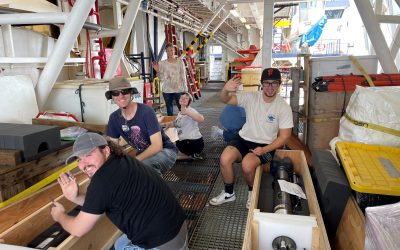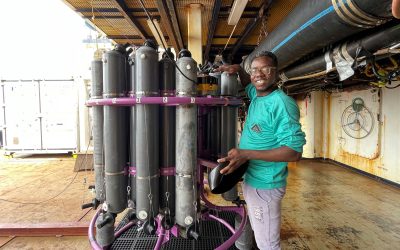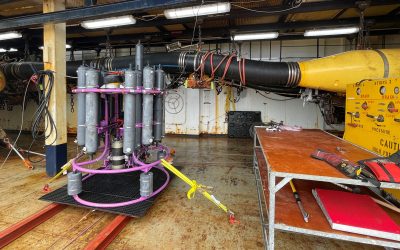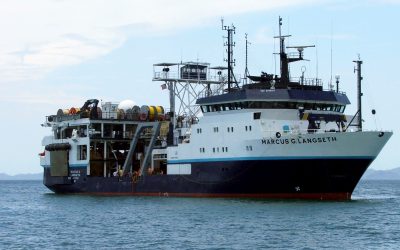2024 GO-SHIP A13.5
Decadal re-occupation of the U.S. GO-SHIP meridional hydrographic line known as A13.5 (0°E in the Atlantic Ocean)
The U.S. Global Ocean Ship-based Hydrographic Investigations Program (GO-SHIP) is part of the international GO-SHIP program, which carries out a systematic and global re-occupation of select hydrographic sections. A13.5 is in the southeastern Atlantic Ocean and was previously occupied in 1984, 1995, and 2010. Attempts in 2020 and 2022 were abandoned due to the pandemic.
Scientists from NOAA and academic institutions will collect full water column CTD rosette casts along the A13.5 section at 30 nautical mile (54km) spacing, with closer spacing at the basin boundaries. Measurements taken from the instrument package include temperature, salinity, oxygen, currents (LADCP), and particles (transmissometer). Discrete samples will be collected on these casts and analyzed for a variety of parameters including salinity, dissolved oxygen, nutrients, chlorofluorocarbons (CFCs), SF6 , dissolved inorganic carbon (DIC), alkalinity, pCO2 , pH, and dissolved organic carbon (DOC). Underway data collection will include upper-ocean current measurements from the shipboard ADCP, surface oceanographic (temperature, salinity, and CO2 ) and measurements from the ship’s scientific seawater supply, meteorological parameters, bathymetric data and atmospheric measurements of CO2 , CFCs, and SF6.
Deployments:
- 11 GO-BGC Navis floats from WHOI that measure biogeochemical properties like chlorophyll, nitrate, and oxygen in addition to temperature and salinity
- 7 EM Apex floats from UW APL that measure, temperature, salinity, velocity, ocean turbulence, and diffusivity
- 4 core Argo floats
- 1 deep Argo float
- 18 surface drifters
The following are the main overlapping scientific objectives:
- Data for Model Calibration and Validation
- Carbon System Studies
- Heat and Freshwater Storage and Flux Studies
- Deep and Shallow Water Mass and Ventilation Studies
- Calibration of Autonomous Sensors.
Please join along on the journey by following the expedition blog!
Chief Scientist: Zach Erickson (NOAA PMEL)
Co-Chief Scientist: Jesse Anderson (Earth and Space Research ESR)
Ship: Marcus G Langseth (Lamont-Doherty research vessel)
Departs: Mindelo, Cape Verde on February 1, 2024
Arrives: Cape Town, South Africa on March 23, 2024
2024 GO-SHIP A13.5 South Atlantic Expedition Logs
GO-BGC Floats
Connecting Classrooms to Near Real-time Ocean Data18 February 2024 The Global Ocean Biogeochemistry Array (GO-BGC) connects their network of marine scientists and the research they are involved in with U.S. classrooms through their Adopt-a-Float outreach program. By...
Current Velocity
The “Journey” of an African Early Career Ocean Professional9 February 2024 My name is Adeola Dahunsi and I’m a doctoral student under the supervision of Prof. Ezinvi Baloïtcha at the University of Abomey-Calavi in the Republic of Benin. I am the lead technician for...
Transit Collaborations
Science Team and Langseth Crew Prepare for CTD Rosette Deployments7 February 2024 We are one week into the cruise! One of the most eye-opening experiences for me so far has been witnessing the close collaboration between the science team and the Langseth crew, who...
A13.5 Intro
An introduction to the US GO-SHIP 2024 A13.5 Expedition aboard the R/V Marcus G. Langseth by Teresa Kennedy1 February 2024 The R/V Marcus G. Langseth departed Mindelo, Cabo Verde today for a 52-day NOAA hydrographic cruise in the eastern south Atlantic Ocean as part...




